Menu
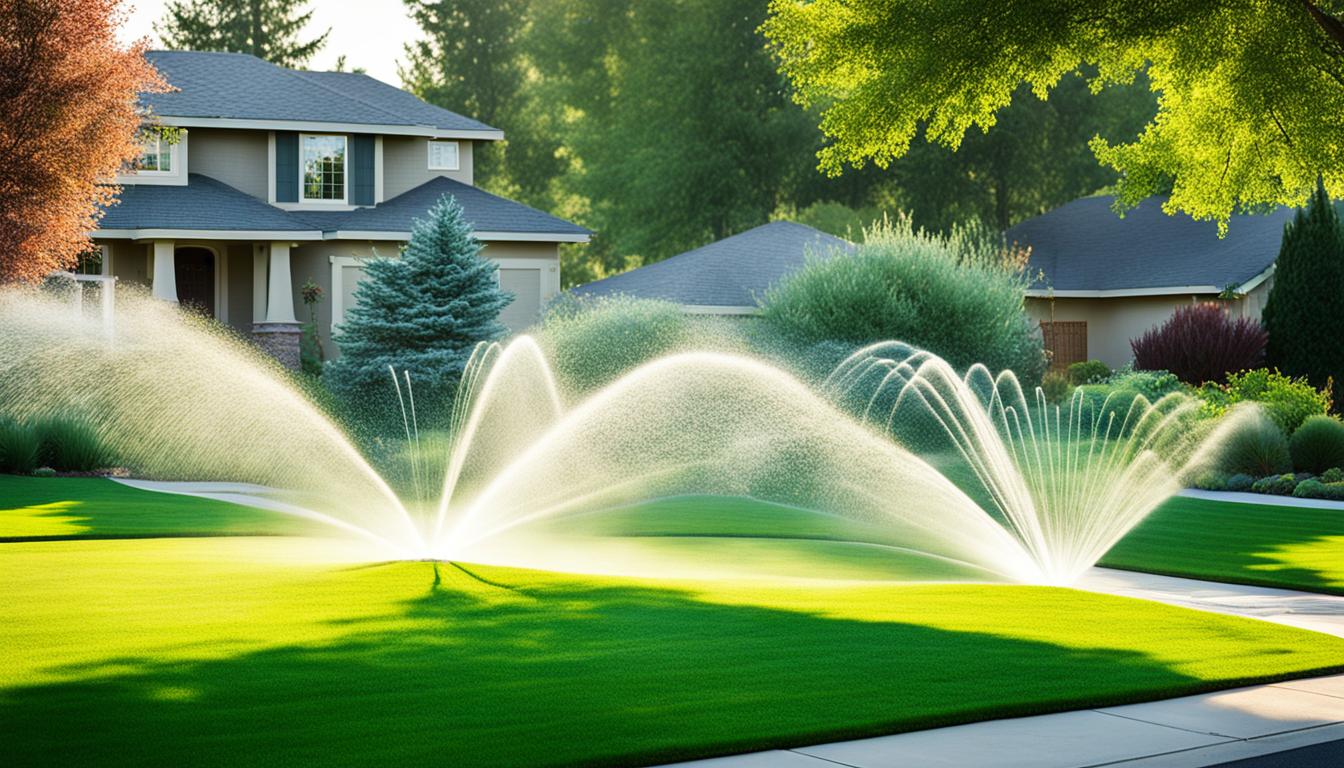
Did you know that homeowners in the Indianapolis area can reduce water use by up to 15%? They achieve this by keeping their irrigation systems in top condition. With proper care, you can have a beautiful lawn all year without worrying about big repairs.
Start by having your system checked by a professional once a year. This helps catch and fix problems early, stopping them from becoming expensive. Checking the system monthly will also keep it running well. It finds issues like blocked sprinkler heads before they cause serious damage.
Adjusting sprinkler heads as the seasons change is key to saving water and making sure your lawn gets the right amount. Checking the system’s settings throughout the year helps avoid watering too much, which can be a waste and costly. Adding a rain shutoff feature helps even more by stopping the system when it’s already raining.
Maintaining your sprinkler system properly not only saves water but also supports a greener way of living. These steps help your lawn stay healthy and look its best.
Looking after your irrigation system all year is key. This approach keeps your system working well and helps save water. It also lowers the impact on our planet by making sure water isn’t wasted.
Staying on top of maintenance stops many problems early. For example, draining your system in winter – important for 85% of systems – prevents freezing damage. A spring check, spotting 70% of issues like broken sprinkler heads, keeps everything running smoothly.
Reopening the shut-off valve in spring is crucial, too. Doing it slowly, as studies show, can reduce damage risk by up to 60%. This simple step protects your system’s parts.
Keeping an eye on your system is vital, especially at the start of spring. It’s when 90% of issues are usually found and fixed. Plus, 75% of homeowners need expert help to get their sprinklers working right, showing the value of professional care.
Taking care of your irrigation system all year not only makes it last longer but is good for the planet and your wallet. It makes sure you use water well in every season.
Maintaining the right water pressure is vital for your lawn care. Look at your sprinkler system often. Doing this finds problems early, like blockages or cracks, that can slow your system down.
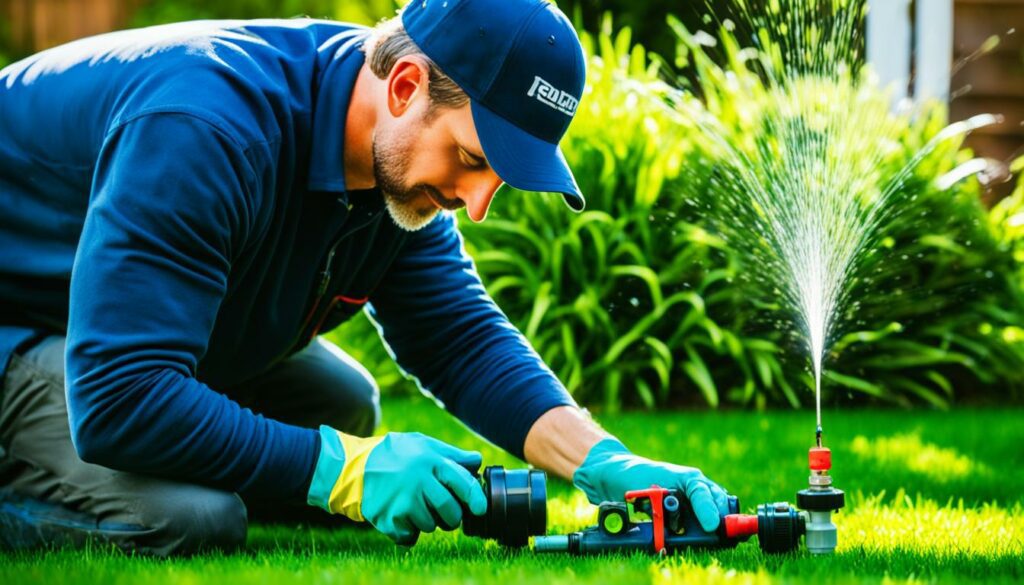
Make sure to check your water pressure regularly. You can spot changes by looking for signs like uneven water or dry spots. Catching these early stops bigger problems, which saves you money and time.
Keeping the right PSI is crucial for your system to work well. For most yards, PSI between 40 to 65 is best. If it’s not in this range, fix it quickly to avoid problems.
Well-maintained systems save up to 15% water and use less energy. This is good for both your pocket and the environment.
| PSI Level | Water Usage | Benefits |
|---|---|---|
| 40 – 65 PSI | Optimal | Efficient coverage, minimal waste |
| < 40 PSI | Insufficient | Dry patches, reduced system efficacy |
| > 65 PSI | Excessive | Overwatering, potential damage to system |
Changing your sprinkler settings with the seasons is key for a lush lawn and less water use. It’s important to look at the season’s temperature changes and how fast water can disappear. Doing this can make your watering system work much better.
As spring rolls around, your lawn will need more water as it grows. You should water more to keep your grass green. In summer, water early to avoid losing water to the sun.
Autumn means you can water less because it’s cooler. Keeping an eye on your sprinklers prevents winter damage. This includes protecting pipes from freezing.
Rain and freeze sensors can help you save water by smartly controlling your system. They make sure your lawn only gets water when it really needs it. This is good for the planet and helps prevent too much water on your lawn.
Here’s a quick guide to making changes when the seasons shift:
| Season | Action Required | Purpose |
|---|---|---|
| Spring | Increase watering frequency | Support new growth |
| Summer | Water early in the morning | Minimise evaporation |
| Autumn | Decrease watering frequency | Conserve water |
| Winter | Monitor for freeze damage | Protect system components |
Checking your system often can help catch problems early like leaks or bad coverage. Getting help from experts for upkeep saves you time and worry. By adjusting your system and using smart sensors, you can cut down water waste and care for the planet.
Winterising your irrigation system is key to prevent damage in cold months. Do this by draining pipes, using air compressors right, and shield sprinkler heads. This keeps your system safe and working well.
To start, drain water from your system’s pipes. Use the right methods whether manual or automatic. Make sure there’s no water left as freezing could damage your pipes. Also, turn off timers to avoid unwanted use in winter.
Air compressors help blow water out efficiently. But, it’s crucial to use them safely. Pick a compressor with a CFM between 80-100 and avoid higher than 80 PSI for PVC. For those unsure, hiring experts like TruGreen is a good plan.
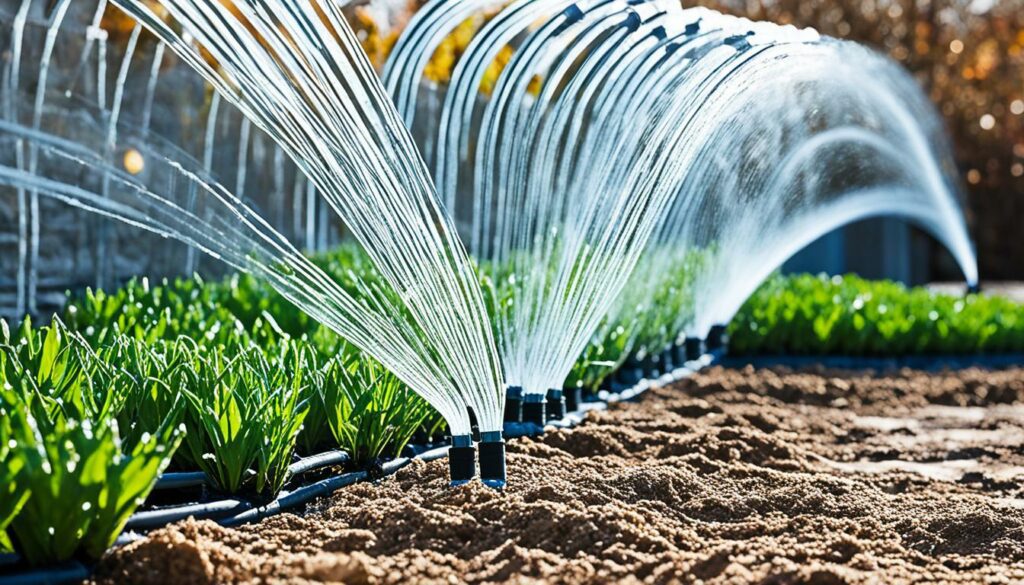
Guarding sprinkler heads is vital too. They could get damaged by ice and snow. Use insulation and protect anything above ground, like shut-off valves. And don’t forget to store hoses properly and insulate outdoor faucets.
It’s essential to keep sprinkler heads clean for top performance. If you don’t, they can get blocked by dirt, grass, or minerals. Clean them well at least twice a year, in late fall and late spring, to avoid problems.
After mowing, make sure to remove any clipped grass around the sprinkler. These blockages reduce the water that reaches your lawn. Wash the heads with clean water or use a brush. Sometimes, you might need to take apart the heads to clean them better.
Hard water can cause minerals to build up in sprinkler systems. This makes them work less effectively. You can deal with hard water by soaking the parts in vinegar or a rust remover. Doing this dissolves the mineral deposits and improves water flow.
| Average Water Depth Needed | Total Minutes Required |
|---|---|
| ⅛ inch | 120 |
| ¼ inch | 60 |
| ½ inch | 30 |
| ¾ inch | 20 |
| 1 inch | 15 |
Maintain your sprinkler system regularly to avoid blockages. A clean system works better, keeping your lawn healthy after each mowing. This is key for your garden to thrive.
Ensuring your sprinkler heads are aligned rightly is key for an adjusting irrigation system and making sure water is spread well. When sprinkler heads are knocked out of place, they can water the wrong areas. This can cause parts of your lawn to be too dry or too wet.
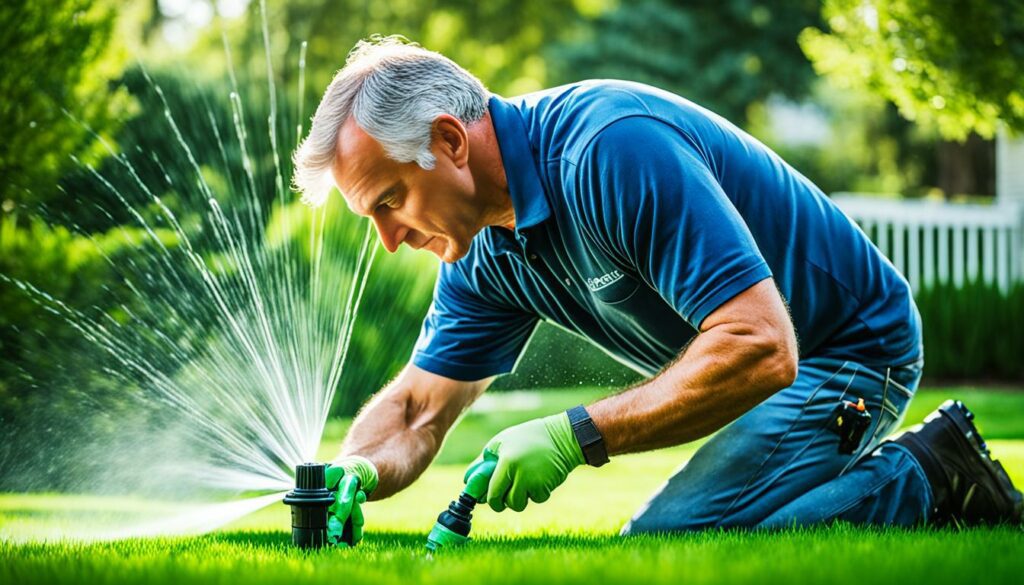
Checking and sprinkler head realignment often helps avoid these issues. Try to look at your sprinklers at least once a year, especially in spring. This way, you fix any problems before it’s too late.
It’s important to use the correct tools for your sprinkler type. For instance, rotor sprinklers need a special tool to adjust them. Whereas, pop-up sprinklers use a simple screw for adjustments. Following the advice of companies like Hunter and Rain Bird is smart.
| Sprinkler Type | Adjustment Method | Price Range | Features |
|---|---|---|---|
| Fixed Spray | Fan width set | $3 to $25 | Fan width: 30-360° |
| Rotor | Radius and arc direction | $5 to $30 | Adjustable spray radius |
| Impact | Rotate for arc | $7 to $30 | Adjustable throw distance |
Having the right tools for adjusting your sprinklers is important. Tools like screwdrivers and wrenches are easy to find. Nozzle insertion collars and adjustment rings also help a lot.
Making a habit of regular care helps a lot. Adjusting and aligning your sprinkler heads keeps your garden evenly watered. This saves water and makes your system last longer. Doing these tasks regularly keeps your system working well and protects it from breaking.
Setting up regular maintenance for your irrigation system is key. It helps keep your watering system running well. By checking it often, you stop small problems from getting big.
This keeps your system in top shape without extra costs. It’s all about making sure your setup works perfectly every time.
When spring comes, it’s time to check your system. This is crucial as plants start growing again. A lot of water at home goes to the garden, so efficient irrigation is very important.
Follow the Utah Division of Water Resources’ advice. They say you should water with ½ inch at a time. This ensures your plants get just enough water.
The Water Check Program from Utah State University is a great help. It tells you how long to run your system. Keeping up with maintenance at the start of the season helps your system work well in summer.
Checking your system in the middle of the season is as important as spring checks. It keeps things working smoothly. This way, you find out what needs changing as the season progresses.
In cities like Cincinnati, where water is important for green spaces, checking often is crucial. With lots of water use in summer, it’s smart to make sure your system is perfect to use.
Getting help from experts like Thomas & Galbraith can be a big plus. They know a lot about maintaining systems. This keeps your water bill low and your system lasting for years. If you’re in Des Moines or nearby, their 35 years of experience can really help you.
Here’s a quick guide on how to keep your system up to scratch:
| Step | Description |
|---|---|
| Spring Inspection | Check and adjust for the beginning of the growing season. |
| Mid-Season Evaluation | Assess system performance multiple times to ensure efficiency. |
| Routine Adjustments | Continuously adjust for changing plant needs and seasonal variations. |
| Professional Assistance | Contact experienced professionals for comprehensive maintenance and repairs. |
Remember to call (515) 289-2020. Get your system checked regularly to keep your garden green all year.
Using smart irrigation tools can change how you look after your garden’s water. With a smart irrigation system installation, you will use water better, watch your system work in real-time, and control it from any place.

Smart sensors for irrigation change watering times by checking the environment. This cuts down water use a lot. For example, soil moisture controllers save 72% on watering and 34% on water compared to how most people water their plants.
These sensors check how moist the soil is and then water the right amount for your plants.
A big plus of smart irrigation is remote irrigation control. Using apps or the web, you can manage your water system from anywhere. So, your garden can stay lush and healthy even when you’re not at home.
In Oklahoma, outdoor water use constitutes around 30 to 50 percent of household water usage. By adopting smart technologies, homeowners can significantly reduce this consumption.
Watching your system from afar shows where you can save more water. This helps the system work better and use water wisely. So, smart irrigation not only saves water but also makes your garden more eco-friendly.
Doing an annual sprinkler system flush is key for keeping your watering system efficient and long-lasting. This process cleans out any built-up debris. This debris could block the system and lower its performance. Just turn on the system and let the water wash it out until it’s clean.
Flushing your sprinkler once a year is also good for saving water. A well-maintained system can use up to 15% less water. So, make sure your system’s PSI is between 40 and 65. This will help prevent damage from high water pressure. Such damage includes broken sprinkler heads and pipes. Avoiding these issues saves you from costly repairs and keeps your system at its best.
Regular irrigation maintenance lets you spot and fix problems early. Flushing your system at least twice annually, especially before winter, stops it from freezing. It also adds years to your system’s life. By making these checks and cleanings routine, you keep your system working well all year long.
| Maintenance Task | Frequency | Benefits |
|---|---|---|
| Annual Sprinkler System Flush | Annually | Removes debris, conserves water, maintains system health |
| Clean Sprinkler Heads | Twice a year | Prevents clogs, ensures optimal water distribution |
| Pressure Adjustments | Seasonally | Avoids damages, ensures efficient irrigation |
Making sure your irrigation system has the right pressure is key to a healthy landscape. Each part of your garden needs a different water pressure. Also, every plant type has its unique watering requirements. Creating a system that matches these needs is crucial.
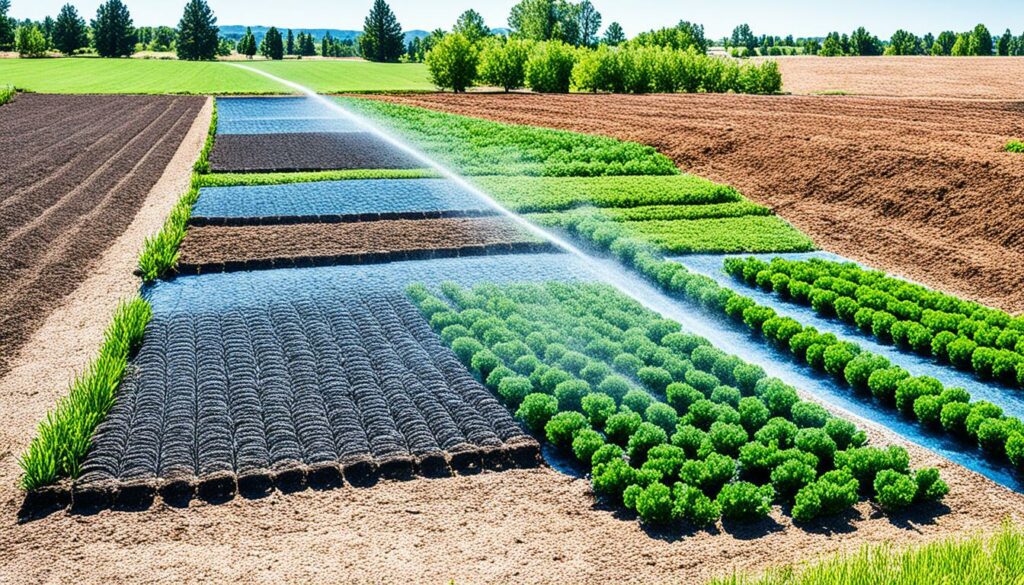
Low volume irrigation is great because it sends water exactly where the plants need it. This lessens water waste and keeps plants evenly moist. It also means fewer weeds since water goes only where it’s needed.
When dealing with various soil types, you must be cautious with your irrigation. Soils like clay, loam, and sand soak up and hold water differently. By tweaking your watering technique for these soils, you can avoid drowning or dehydrating your plants.
To keep your garden in top shape, it’s vital to consider the soil and climate. Each area requires a plan that fits its specific needs.
| Soil Type | Water Absorption | Ideal Irrigation Method |
|---|---|---|
| Clay | Slow | Low volume or drip irrigation |
| Loam | Medium | Sprinkler system with moderate pressure |
| Sand | Fast | Frequent, short watering with high efficiency nozzles |
By adjusting your irrigation for soil types, you can significantly boost your landscape. This method optimises water use, ensuring your garden thrives with the precise amount of water each plant needs.
Maintaining your irrigation system well means spotting and fixing leaks quickly. This stops water waste and stops your garden from being damaged. Keep an eye on your water use and check things often. This way, if a leak starts, you can sort it out fast.
Many things show you might have a leak. A big jump in water use with no clear reason is a big hint. Watching your water meter can hint at a hidden leak. Always look for puddles or wet patches in your garden. Those also show a possible leak.
Use dye testing or check if the soil is wet in places where it shouldn’t be. These can help spot leaks under the radar. Changes in water pressure or weird plant growth can also mark a leak. Early spotting and fixing are key to stop the issue from growing.
Some fixes, like cleaning sprinklers, you can do yourself. But for complicated or ongoing leaks, a pro is the best bet. Expert repair folks are good at finding and fixing these problems. They are your go-to for a lasting solution.
Choosing a repair service brings you many perks. They have the skills to fix things right and safe. Plus, their work is often covered by a warranty. You won’t have to worry. They can also quickly solve any urgent repairs your system needs.
Regular check-ups and adjustments can catch leaks before they become bigger problems. This way, you not only save water but also keep your garden healthy. It’s a smart and eco-friendly way to manage your irrigation system.
It’s crucial to check your irrigation system every month. Doing so ensures it works as it should. Regular checks can stop big problems before they happen.
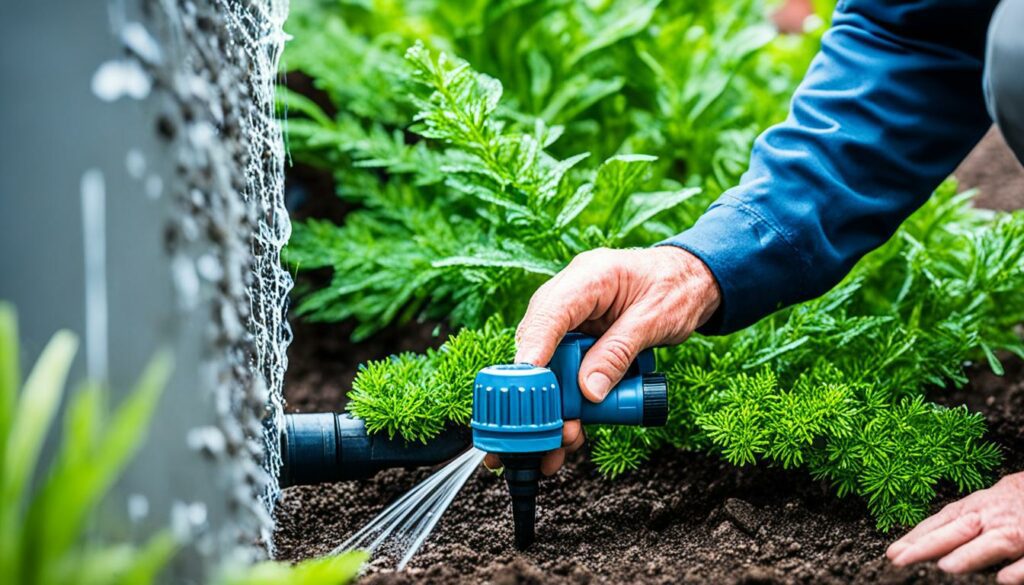
I mimic real watering to test everything. By turning on different places and watching water flow, I can spot issues. These checks can uncover problems like misplaced sprinkler heads or signs of leaks early.
It’s important to always look at how your system waters. I focus on how far and evenly water spreads. If I find dry areas or places getting too wet, I make sure to fix it.
By taking these steps, I make sure your system works well and saves water. So, keeping up with checks every month is key to a healthy yard.
It’s vital to adjust sprinkler heads carefully. This is key for good lawn irrigation and even water spread. Doing this well can cut down on water waste. Plus, it helps keep your lawn looking its best. Here are some steps and tricks to tweak different sprinkler heads for top performance.
Make sure your sprinkler heads water the right spots. Brands like Hunter make tools for this job. If you see dry patches, boost the water. For wet areas, maybe turn it down.
Rotary sprinkler heads are a bit different. You turn a key to change how far the water reaches. This lets you adjust the water better across your lawn.
When aligning spray head alignment with pop-ups, remember some nozzles can’t change. But some can, with the right tool. Use a flat-head screwdriver to tweak them for your lawn’s layout.
With impact sprinklers, you can twist the head to change the water’s path. This is handy for areas needing special attention.
Getting sprinkler heads just right is more than just about water for your lawn. It also helps your system last longer. Keep up with maintenance, use the best tools, and your garden will thank you. Plus, your water bill will be lower.
Setting your irrigation controller right can make a big difference. It can make your system work better, use less water, and keep your plants healthy all year. Make sure to adjust it as the seasons change.
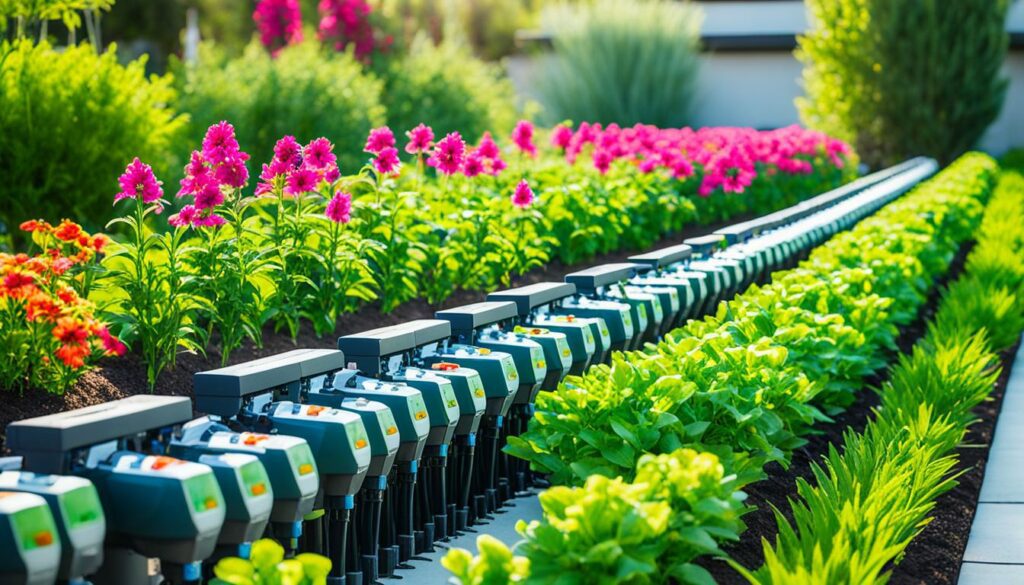
As the seasons change, so should your watering schedule. In spring and summer, your lawn needs more water. But in autumn and winter, cut back. This saves water and stops your plants from getting too much.
Adding moisture sensors can help a lot. They check how wet the ground is and adjust your watering schedule. When you put them in, pick spots where the ground is normal. This way, they’ll give you better information.
Rain shutoff devices are smart additions. They stop watering when it’s raining. This saves water and lowers your bills. Using them means your system always waters when it’s needed, no matter the weather.
To keep your system in top shape, check it often. Look for any problems and test it regularly. This makes sure everything works as it should.
| Optimisation Aspect | Key Information | Benefits |
|---|---|---|
| Seasonal Setting Adjustments | Adjust irrigation to match seasonal weather variations. | Conserves water and ensures healthy plant growth. |
| Soil Moisture Sensors | Monitors soil moisture levels for precise irrigation. | Prevents overwatering and promotes root health. |
| Rain Shutoff Devices | Automates watering pause during rainfall. | Reduces water bills and prevents wastage. |
| Regular Maintenance | Includes inspections, pressure tests, and troubleshooting. | Maintains system efficiency and prevents damage. |
Older irrigation systems can get a big boost from upgrades. They see major efficiency gains by using today’s irrigation tech. When irrigation experts set up the controller properly, you save a lot of water.
Adjusting the system based on the season makes it even better. The settings should change from spring to dry August. Nozzles that use water wisely can spread larger droplets effectively, limiting waste.
Drip irrigation focuses water directly on plants, cutting down on water lost to air. Having experts check your system regularly keeps it in top shape. They fix small problems early, like misaligned sprinkler heads and blockages.
Smart systems are a big step forward. They notice and alert you to problems like leaks or electrical faults. These save water and cash. They also allow you to control and check the system with your phone, thanks to WiFi.
Using PRS heads can save a lot of water – up to 46,000 gallons yearly. As your garden changes, your irrigation system might need updates. This keeps everything working well. Adding or moving sprinkler heads can also make your water use more efficient.
Not having enough money often keeps people from upgrading their systems. But, spending a little now can save a lot later on. It’s good for the planet and makes your garden look better. A smarter, water-saving garden is very doable with the right choices.
| Upgrade Type | Benefit |
|---|---|
| High-efficiency nozzles | Reduces water waste with larger droplets |
| Drip irrigation | Targets plants directly, reducing evaporation |
| Pressure-regulating (PRS) heads | Saves up to 46,000 gallons/year |
| Smart irrigation systems | Alerts to issues, saving water and money |
| WiFi-connected control equipment | Enables remote monitoring and management |
Maintaining your irrigation system is more than keeping your lawn looking good. It helps you avoid expensive repairs and problems. Spotting issues like water not spreading evenly or low pressure early can prevent major headaches. Cleaning sprinkler heads, looking for leaks, and checking water pressure ensures your system works well.
For small troubles, like clearing clogged heads, do it yourself. But complex issues need a pro. Choose a repair service with a good track record, the right papers, and affordable rates.
Using smart systems and updating them every 10 to 20 years saves water and energy. Flushing the system and regular maintenance are key. They keep things running smoothly and catch problems early.
Consistent maintenance and making tweaks by season keeps your lawn lush all year. These tips cut water use by 15%. This means lower bills and helps the planet. By looking after your system, you enjoy a lovely landscape for longer.
Maintaining an irrigation system is vital for a healthy lawn and garden. It helps avoid costly repairs. Plus, it uses water more effectively, making the system last longer.
Year-round care for the system helps save up to 15% water. It also lessens the system’s negative effect on the environment. This is because it ensures the system works well, using water efficiently.
Regularly checking water pressure helps spot issues early on. Most lawns should have a PSI of 40 to 65. If it’s not in this range, there may be a problem needing expert attention.
Changing the sprinkler schedule by season prevents waste and wear. Using rain or freeze sensors can help do this automatically. It makes sure your system only runs when it needs to.
To get your system ready for winter, first drain it. Then, use an air compressor to clear any leftover water. It’s best to get a professional to do this part. Finally, protect your sprinklers from snow and ice.
You should clean your sprinkler heads often to avoid clogs. This is especially true after mowing the lawn. Giving them a deep clean or soaking them in a rust remover can help if there’s mineral build-up.
Failing to keep sprinkler heads in the right position can waste water. Things like wind or people walking can knock them out of place. Fixing their angles stops wear on your system and makes water distribution even.
Maintaining your system in the spring and during the season is wise. This helps catch small issues early. It means your system will perform well for longer and avoids bigger problems.
Smart tools make watering easier and save water. They notice changes in the weather and check the system’s status. You can also control them from afar. This helps find issues early and saves water.
Flushing your system each year stops debris build-up and potential clogs. You know it’s clear when the water runs clean. This keeps your system healthy and efficient.
Each area of your garden may need a different water pressure. Plants like low pressure for gentle watering. High pressure is better for open, sunny spots. Ensuring the right pressure matches your landscape type saves water and keeps your plants happy.
Finding and fixing leaks early is key to saving water and landscape health. Look out for wet or soggy areas. If you notice this, get a professional to check and fix the issue.
Testing and inspecting your system monthly is a good practice. By doing so, you can see if water is being distributed evenly. It also helps you find and solve problems early.
Making sure your heads are aimed right saves water and ensures good coverage. This means checking and, if needed, changing their position. It helps achieve equal watering throughout your garden.
Setting the controller right for each season saves a lot of water. Devices that stop watering in the rain are great for this. They improve your system’s water use.
Improving your old system makes watering more efficient. Modern technology can save water and lower costs. This means better, more reliable watering with savings in the long run.